We are pleased to announce an exciting new alliance between Active Living Research and GP RED to co-host and coordinate...
A University-Community Partnership to Create and Evaluate Environmental Changes in Disadvantaged Areas

Presentation at the 2010 Active Living Research Annual Conference
Background:
People living in economically disadvantaged areas have less access to environmental supports for physical activity (PA), such as safe and convenient parks, playgrounds and walking trails. As part of an ongoing, community-based participatory research project to enhance environmental and policy supports for an active community environment, the research team partnered with a citizens' community coalition to implement and evaluate a community mini-grant initiative in a Southeastern US rural county.
Objectives:
The purpose of the mini-grant program was to partner with local groups to implement environmental changes supportive of PA in disadvantaged areas, such as trail building, park revitalization, and enhancement of recreation fields/playgrounds through provision of small grants. The mini-grant program allowed local community groups to identify a project that was culturally acceptable for their community. A second objective was to engage representatives from the applicant communities in developing their grant writing and management skills, and in evaluating the use of the newly installed amenities. This report describes the initiative and reports observational data collected in 2008.
Methods:
The accessibility/outreach committee of the community coalition collaborated with the research team to establish the mini-grant program guidelines. Nonprofit organizations, schools, faith-based organizations, and neighborhood associations were encouraged to apply. Less-experienced organizations were encouraged to partner with more-experienced organizations. All interested groups submitted a letter of intent and attended a pre-application workshop to learn details of the application process. Applications were reviewed by an external review committee with experience working with community-based organizations and grants. Funding decisions were based on reviewers' scores and the proposals' fit with the program guidelines. All groups received scores and written feedback on the quality of their application. Community groups not funded were offered technical assistance to identify other potential financial sources and encouraged to re-apply during the next mini-grant funding cycle. All community groups that received a mini-grant documented the progression of their project via pre- and post-construction photos. Some of the community groups also administered a citizen opinion survey to document the impact of their project. The System for Observing Play and Activity and Recreation in Communities (SOPARC) was used to assess trail and park use. SOPARC was originally designed to better understand PA in community and recreational settings, and requires the systematic direct observation of users of such settings by trained staff. Eight community members and three graduate students were trained and conducted direct observations from June 20, 2008 (Friday) thru June 26, 2008 (Thursday) to provide baseline data for longitudinal evaluation for four of the sites. During visual scans, the PA level of each user was coded as Sedentary (i.e., lying down, sitting, or standing), Walking, or Very Active (vigorous PA such as jogging or cycling). Separate scans were made for females and males and for coding trail and park users into perceived age and ethnicity groupings. Observations of trail and park users were made 4x/day (7:00-8:30am, 11:00am-12:30pm, 3:00-4:30pm, 6:00-7:30pm) at each site for 7 consecutive days.
Results:
From 2005-2007, 22 community groups attended mini-grant orientation sessions. Of those, 13 submitted applications and five received funds ranging from $2,700-$15,000. One community group not awarded funding accepted the offer for technical assistance to identify another funding source and enhance its application. This community group subsequently received a small grant from a private foundation. Another organization not funded received a mini-grant during the next application cycle. Environmental improvements implemented by the five initially funded projects included the installation of 3 walking trails/paths, revitalization of one park, and enhancement of one school playground (under construction during observations and not assessed). During seven days of data collection in June 2008, 231 total users were observed across the four sites (53% adults/seniors, 47% children/teens; 53% female; 27% white, 73 % black). The total number of users at individual sites ranged from 35-104 over the seven day period. A majority of users were observed during early morning and evening hours (daily air temperature ranged from 65o-96o). The days of the week with most use differed across sites with users on weekends accounting for 8%-90% of all users. The various facilities (e.g., trail, playground, ball field, picnic area) most used also varied across sites depending on the presence of these facilities.
Conclusions:
A participatory, community-university research partnership proved a valid means to deliver resources to, and evaluate impacts in, disadvantaged communities endeavoring to create an active community environment. Regardless of any differences in user characteristics between sites, the direct observations provided meaningful baseline data that can be used by the communities to improve promotion and increase use of their activity-friendly environments. Follow-up direct observations will indicate if such efforts are successful over time.
Support:
This work was supported by the Centers for Disease Control and Prevention (CDC) [cooperative agreement 1-U-48-DP-000051]. Contents of this abstract are solely the responsibility of the authors and do not necessarily represent the official views of CDC.
STAY UP TO DATE
RECENTLY ADDED TOOLS & RESOURCES
MOVE! A BLOG ABOUT ACTIVE LIVING
The "Active Living Conference" aims to break down research and practice silos and...







